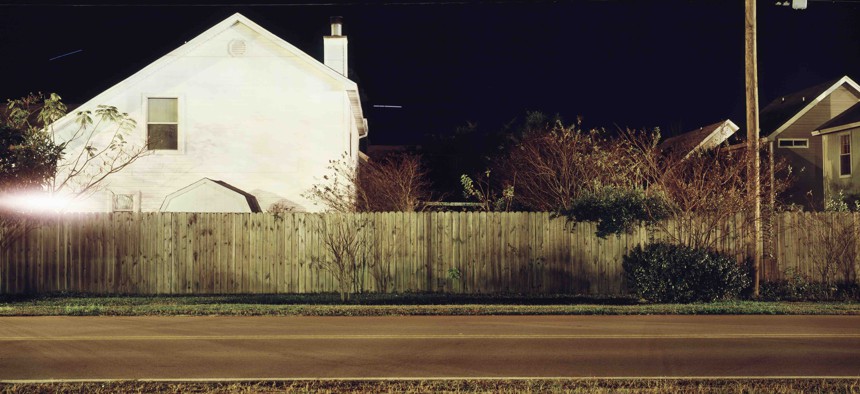Housing Slump Would Place Greatest Stress on Black, Hispanic Residents

Erik Von Weber/Getty Images

Connecting state and local government leaders
Many homeowners have counted on fast-rising home values and growing home equity.
This story was originally posted by Stateline, an initiative of the Pew Charitable Trusts.
If the United States enters a recession and housing prices stagnate or fall, homeowners in parts of California, Delaware, Illinois, Indiana and New Jersey are most at risk of owing more than their houses are worth or losing their homes to foreclosure, according to a new analysis.
ATTOM, a real estate data company, identified the most at-risk counties based on affordability, foreclosure filings, unemployment levels and the share of homes with mortgage balances exceeding property values. On average, counties where Black and Hispanic residents are the largest group were judged to be at least twice as vulnerable to housing market declines as counties where White residents are the largest group, according to a Stateline analysis of census and ATTOM data.
The Federal Reserve’s effort to curb inflation by raising interest rates is expected to cool the red-hot housing market—but not immediately. For now, there is still strong demand for the limited supply of houses and apartments, and unemployment remains low. Most experts expect housing prices to continue to rise this year.
Home prices increased a record 21% in the past year, the largest increase in 30 years, and rents rose 12% nationally, according to the report. Rents were up by as much as 20% in some East Coast areas where prices had moderated earlier in the pandemic, according to a June study released by the Harvard Joint Center for Housing Studies.
But with some analysts predicting a recession, homeowners who have gotten used to fast-rising home values and growing home equity might be in for a shock.
The most at-risk market, according to the ATTOM rankings, is Passaic County, New Jersey, home to Paterson. It takes nearly half the median annual income of about $64,000 to maintain a mortgage on the typical $415,000 home there. Experts recommend spending no more than 30% of income on housing.
Paterson has drawn new interest from investors looking to capitalize on the city’s proximity to Manhattan, New York, about 20 miles away. The entry of investors into a market can raise home prices and rents, pricing out longtime residents with lower incomes.
Passaic County is 43% Hispanic and 13% Black, and many residents with low incomes stitch together a variety of part-time jobs to get by with wages of about $14 an hour, said Debbie Nicholson, a housing counselor at the nonprofit Paterson Task Force for Community Action in Passaic County.
ATTOM also identified six other New Jersey counties, seven in Illinois, two in Delaware and one each in California, Indiana, North Carolina and Texas among the 20 counties most vulnerable to a downturn.
The disproportionate at-risk status of Black and Hispanic counties is particularly troubling since households of color made up most of the growth in homeownership in recent years, according to the Harvard report.
Households of color accounted for half of the total growth in homeowners between early 2016 and early 2022, and even a larger share (55%) of the increases over the past two years.
“People of color drove most of the housing growth last year, and will continue to do that, yet the racial homeownership affordability gaps that we see continue to expand,” said Alanna McCargo, president of the federal Government National Mortgage Association, or Ginnie Mae, speaking at a June 22 online event sponsored by the Harvard Joint Center on Housing Studies.
“This is not sustainable,” McCargo added. “This is a thing we will have to grapple with at the federal, state and local level.”
New Jersey and Illinois each had seven of the 20 most at-risk counties in ATTOM’s rankings, while Tennessee had five of the 20 least at-risk counties, including Davidson County, which includes Nashville.
In Davidson County, payments on a typical $378,000 home would consume about 28% of the median $64,000 income. North Carolina’s Durham County, which is 36% Black and 15% Hispanic, also was one of the least at risk, with payments on a $342,000 home consuming just 22% of the median $66,000 income.
Some states have both high-risk and low-risk counties: Indiana’s Lake County near Chicago was one of the 20 most stressed. Tippecanoe County, less than 100 miles away, was one of the 20 least stressed.
There were similar gaps in California between wealthy San Mateo County, south of San Francisco, and inland Madera County near Fresno; and in Texas, where booming Travis County (home of Austin) was among the least at risk, and Webb County, at the border 300 miles away, was among the most at risk.
In wealthier areas, prices are likely to keep rising for now as affluent people compete for scarce homes, whether they’re apartments or single-family houses. States may have to lead the way in creating more multifamily housing to increase the supply and eventually stabilize prices, said Chris Herbert, managing director of the Harvard housing center.
“There’s a tale of two cities. The overall housing market has a certain amount of strength that will carry through, but for those at the bottom and even the middle of the income distribution, it’s been tough to get a toehold and it’s getting harder,” Herbert said.
If soaring home prices start to fall, it could lower rents in largely Black and Hispanic areas, where low-income residents struggle to afford housing near their jobs. That could happen in 2023, Herbert said.
“Frankly, if housing prices moderate and rents moderate, that’s not a bad thing.”

NEXT STORY: Trump Wades Into One State's Budget Discussions




